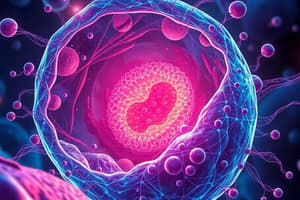Podcast
Questions and Answers
¿Cuál de las siguientes partes de la célula es responsable de producir energía celular en forma de ATP?
¿Cuál de las siguientes partes de la célula es responsable de producir energía celular en forma de ATP?
- Ribosomas
- Retículo endoplásmico
- Aparato de Golgi
- Mitocondrias (correct)
¿Qué función principal cumple el retículo endoplásmico en la célula?
¿Qué función principal cumple el retículo endoplásmico en la célula?
- Almacenar agua y nutrientes
- Producir energía en forma de ATP
- Procesar y modificar proteínas y lípidos (correct)
- Regular el paso de sustancias hacia y desde la célula
¿Cuál es la función principal del aparato de Golgi en una célula?
¿Cuál es la función principal del aparato de Golgi en una célula?
- Sintetizar carbohidratos
- Almacenar información genética
- Procesar y modificar proteínas y lípidos (correct)
- Producir hormonas
¿Qué parte de la célula contiene la información genética de la misma?
¿Qué parte de la célula contiene la información genética de la misma?
¿Cuál de las siguientes estructuras celulares es conocida como la 'central energética' de la célula?
¿Cuál de las siguientes estructuras celulares es conocida como la 'central energética' de la célula?
¿Cuál de las siguientes afirmaciones describe mejor la función de los lisosomas?
¿Cuál de las siguientes afirmaciones describe mejor la función de los lisosomas?
¿Cuál es la función principal de los ribosomas en la célula?
¿Cuál es la función principal de los ribosomas en la célula?
¿Qué función realizan los cloroplastos en las células vegetales?
¿Qué función realizan los cloroplastos en las células vegetales?
¿Cuál de las siguientes NO es una función celular esencial mencionada en el texto?
¿Cuál de las siguientes NO es una función celular esencial mencionada en el texto?
¿Cuál es el proceso celular crucial para la reproducción sexual y produce gametos con la mitad del material genético usual?
¿Cuál es el proceso celular crucial para la reproducción sexual y produce gametos con la mitad del material genético usual?
Flashcards are hidden until you start studying
Study Notes
Unlocking the Secrets of Cellular Life: An Introduction to Cell Biology
Cell biology, a fundamental discipline, delves into the inner workings of life's smallest and most diverse building blocks—cells. To understand the intricate dance that occurs within these miniature factories, let's explore the structure, organelles, functions, and the processes that define cellular life.
Cell Structure
Most cells share a common structure, which includes a cell membrane, cytoplasm, and nucleus. The cell membrane (plasma membrane) is a selectively permeable barrier that separates the internal environment from the external one, maintaining homeostasis. The cytoplasm is a complex, dynamic mixture of proteins, lipids, and other molecules that interact to carry out cellular processes. The nucleus contains the cell's genetic information, housed within the double-stranded DNA molecule and packaged into chromosomes.
Cell Organelles
Cells are home to numerous specialized units called organelles. Some major organelles and their functions are:
- Mitochondria, the cellular powerhouses, produce cellular energy in the form of ATP through cellular respiration.
- Endoplasmic reticulum is a continuous, membranous network that aids in protein synthesis and lipid production.
- Golgi apparatus processes, modifies, and sorts proteins and lipids before they are transported to their final destinations.
- Lysosomes are the cell's "digestive system" which break down and recycle cellular waste.
- Ribosomes are the sites of protein synthesis, where the genetic information from mRNA is translated into proteins.
- Chloroplasts, in plant cells, capture sunlight to produce energy through photosynthesis.
Cell Functions
Cells carry out essential functions such as:
- Metabolism, the conversion of nutrients into energy and essential cellular components.
- Biosynthesis, the production of complex molecules, such as proteins and nucleic acids.
- Signal transduction, the transmission of signals from the cell surface to the nucleus to regulate cellular processes.
- Transport, the movement of molecules, ions, and organelles across the cell membrane to ensure homeostasis.
Cell Division
Cells must divide to grow, repair damage, and maintain homeostasis. Cell division occurs through two main processes.
- Mitosis is the process of equal division of genetic material and cytoplasm, resulting in two genetically identical daughter cells.
- Meiosis is a specialized form of cell division that produces sex cells (gametes) with half the usual amount of genetic material. This process is crucial for sexual reproduction.
Cell biology is a dynamic field, continuously advancing our understanding of the cellular world. From discovering the mechanisms behind cellular communication to resolving the molecular basis of diseases—each new finding adds to the rich tapestry of cell biology.
Studying That Suits You
Use AI to generate personalized quizzes and flashcards to suit your learning preferences.




